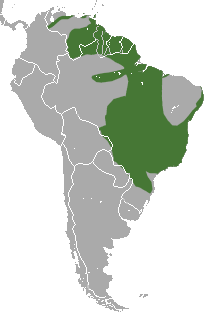Caluromys philander
| Bare-tailed woolly opossum | |
|---|---|
 |
|
| Scientific classification | |
| Kingdom: | Animalia |
| Phylum: | Chordata |
| Class: | Mammalia |
| Infraclass: | Marsupialia |
| Order: | Didelphimorphia |
| Family: | Caluromyidae |
| Genus: | Caluromys |
| Subgenus: | Caluromys |
| Species: | C. philander |
| Binomial name | |
|
Caluromys philander (Linnaeus, 1758) |
|
| Subspecies | |
|
|
 |
|
| Range of the bare-tailed woolly opossum | |
| Synonyms | |
|
Didelphis philander Linnaeus, 1758 |
|
Didelphis philander Linnaeus, 1758
Philander philander Cabrera, 1919
The bare-tailed woolly opossum (Caluromys philander) is an opossum from South America. It was first described by Swedish zoologist Carl Linnaeus in 1758. The bare-tailed woolly opossum is characterized by a gray head, brown to gray coat, orange to gray underside and a partially naked tail. It is nocturnal (active mainly at night) and solitary; there is hardly any social interaction except between mother and juveniles and in mating pairs. The opossum constructs nests in tree cavities, and its litter size ranges from one to seven. Gestation lasts 25 days, and the juveniles exit the pouch after three months; weaning occurs a month later. The bare-tailed woolly opossum inhabits subtropical forests, rainforests, secondary forests and plantations; its range extends from northern Venezuela to northeastern and southcentral Brazil. The IUCN classifies this opossum as least concern.
The bare-tailed woolly opossum is one of the three members of Caluromys, and is placed in the family Didelphidae in the marsupial order Didelphimorphia. It was first described by Swedish zoologist Carl Linnaeus as Didelphis philander in the 10th edition of Systema Naturae (1758). It was given its present binomial name, Caluromys philander, by American zoologist Joel Asaph Allen in 1900. A 1955 revision of marsupial phylogeny grouped Caluromys, Caluromysiops, Dromiciops (monito del monte) and Glironia (bushy-tailed opossum) under a single subfamily, Microbiotheriinae, noting the dental similarities among these. A 1977 study argued that these similarities are the result of convergent evolution, and placed Caluromys, Caluromysiops and Glironia in a new subfamily, Caluromyinae. In another similar revision in 2009, the bushy-tailed opossum was placed in its own subfamily, Glironiinae.
...
Wikipedia

